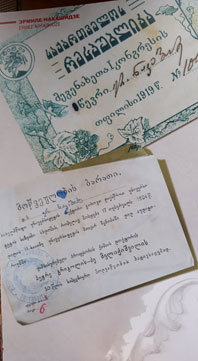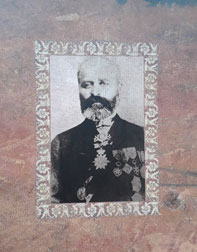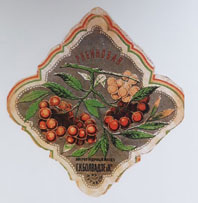
Ermile Nakashidze and George Bolkvadze - Country of Liquid Sun
Monday, May 4
Well-known Georgian agronomist, and pioneer of agronomical activities in Georgia, Prince Ermile Nakashidze, was born in the village of Makvaneti in the province of Ozurgeti. He was one of the first persons whose activities in regard to vine growing and wine making cannot be overestimated.
After finishing Ozurgeti City School in 1879, Nakashidze enrolled in the Kutaisi Classical Gymnasium. He was the cousin of Ekvtime Takaishvili. Niko Mari, his great friend, studied together with him at the Gymnasium in Kutaisi. In 1883, now a successful graduate, he continued his studies at the Agricultural and Forestry Institute of Novoalekseevka in Poland on a scholarship from the Kutaisi Prince's Bank. Nakashidze was the only student from the Caucasus in this Institute. In 1886, after his graduation, he returned to Georgia.
Nakashidze had close friendships with well- known agronomists: A. Sharashenidze, D. Gedevanishvili, S. Cholokashvili, K. Modebadze, T. Kvaratskhelia and I. Lomouri all of whom had greatly contributed to the development of the practical and theoretical foundations of Georgian vine growing. Young agronomists, who afterwards became prominent scientists, often had meetings in Nakashidze's family.
Ermile Nakashidze, primarily, turned his attention towards the condition of vine growing and wine making in the regions of Guria, Samegrelo, Ajara and Abkhazia, in particular. He dedicated many reports, articles and monographs to a number of urgent issues in the country.
From 1877-1892, Nakashidze was the principle of the newly-established Agricultural School in Tsinamdzgvriantkari. The School trained many specialists in the field. From 1892-1896, he worked with the Caucassian Phylloxera Committee and as an agronomist-inspector at the Land Farming Department from 1896-1906. Nakashidze returned to Ozurgeti and lived there from 1905-1911and continued working in the Ministry of Land Farming from 1911-1921.
Ermile Nakashidze died at the age of 78. His contribution, as a prominent specialist and scientist in the field of agricultural, remains invaluable. He lived and worked during a period when well-educat- ed and professional agronomists were scarce in Georgia. In such a difficult situation, an agronomist needed a rather diverse knowledge in order to properly direct a diversified Georgian agriculture.
The contribution of Giorgi Bolkvadze, a famous technologist and businessman, in the development of Georgian alcoholic beverages, remains, unfortunately, under appreciated. Bolkvadze, who produced alcoholic beverages beginning in 1865, further expanded and developed his production at the end of the nineteenth century.
Giorgi Bolkvadze started an alcohol factory and began the production of vodka and other alcoholic beverages in Kutaisi and established a wholesale outlet in the factory's warehouse. In 1895, Mr Muravliov, a merchant in Kutaisi, purchased Bolkvadze's factory together with its warehouse and invited another merchant, Parsadan Avsarkisov who joined him in establishing Muravliov's Vodka Factory and Wholesale Warehouse. That same year, Avsarkisov purchased the factory with his funds and together with Giorgi Bolkvadze founded a new firm, Bolkvadze and KO.Co. Avsarkisov was in charge of financial issues and Bolkvadze was responsible for those related to technological, technical and distribution issues.
Bolkvadze's factory in Kutaisi was located at the crossing of Mikheil and Gymnasium Streets. It had its trademark: an eagle from 1873 and the monogram of Bolkvadze's name and surname in Russian, ΓΑΚ from 1865.
Raw materials, from which Bolkvadze produced the alcohol, came from Georgia with his factory being the only well operating enterprise at that time using modern equipment. His rectifying and distilling equipment and plants as well as the bottling and corking machines and the filters were imported from Europe. The cognacs produced by Bolkvadze's firm-Dzveli (Old) No. 1, Khelovnuri (Artificial) No. 3, Natural Caucasian Cognac, absinthe, rum No. 3, currant liqueur, ash berry liqueur, vodkas, purified wine No. 10, double distilled wine , Royal Vodka and other products-won over 60 different prizes at competitions, fairs and exhibitions in various European and American cities including grand prizes, golden medals, diplomas and others. The vodka Kina-Kina (Quinine), which he produced, was especially popular with its label listing the whole set of medals which it had won.
In addition to the form and trademarks, the export labels were also written in Russian and French as well as the advertising signboards, business cards and letterheads which also featured the figures of the horse and lion and the crowns of the Russian Empire. Bolkvadze and KO, Kutaisi, Factory of Liqueur, Rum, Cognac and Absinthe was written on each and every label of his products.







